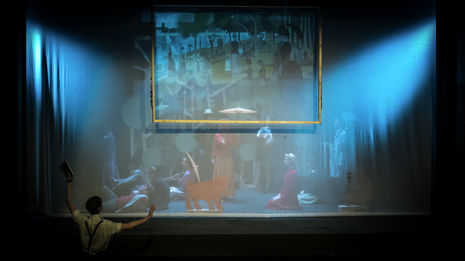Colour & light: a dialogue on ‘Sunday in the Park with George’
Gina Stock and Orla Hogan discuss the themes, performances, and design of this complex musical about art

Sunday, Sunday, Sunday: a word uttered so many times in Stephen Sondheim and James Lapine’s Sunday in the Park with George that we lost count. The musical is no small technical feat. It traverses the life and legacy of painter Georges Seurat, reimagining his art in a characterful and colourful way.
Reflecting the fluidity and experimentation of the production we have adopted a more experimental form of reviewing, entering into dialogue with one another to uncover moments where we align and differ in our viewing experience.
Gina: Dylan Evans’ directorial vision explores the artist’s inner conflict between the personal and the professional — and its influence on human relationships. This, at times, translated into beautiful moments of clarity and consistency, and other times into moments of excessive simplicity, which still left an overall sense of serenity in the atmosphere of the production.
“The production retains elements of incredible spirit and human emotion”
Orla: In my experience, musicals always risk becoming too animated and too theatrical, but Evans’ production found the perfect balance between the two. Despite its script being packed with interpersonal conflict, the production’s first act showcased the serenity of a French island while honouring the stress of a young artist trying to succeed.
Gina: Evans’ staging, while at times minimalistic, created the perfect equilibrium between the overstimulating noise of the titular park and the stillness of art, making one feel as though they were also seeing the world through George’s lens.
Orla: That minimalist staging was supported by the innovative set design. Designed by Tungsten Tang, it was the most outstanding part of the show and created much of the action even when the blocking itself felt stagnant. The design allowed the stage to become the liminal space between an artist, his muses, and a completed artwork.
Gina: Tang opted for abstract, layered shapes which physically played into the pointillist technique used by Seurat in his paintings. Whilst this represented trees and animals beguilingly, on other elements of the set, like the painted backdrop, it took on a distractingly unfinished look. This did not completely detract from the overall cohesion though, as the set was seamlessly woven into the action and aided the transition between George’s art and reality.
Orla: The musical houses two distinct time periods — 19th-century France and 1980s’ America. One of my favourite parts of the production was the use of projection to include Seurat’s paintings within the set. Projection onto a sheer curtain marked the transition between real life and art and transformed the stage into its own ‘gallery’.
“Minimalist staging was supported by the innovative set design”
Though the set’s fluidity charms in the first act, it fails to capitalise on that same charm in the second half of the evening — its versatility adequately captures both time periods the show covers, but it was more successful in evoking elements of the island in France. This was compounded by a generally less convincing second act. A transition to American accents felt jarring and the actors seemed less comfortable adopting them. Blocking seemed less intentional, which was particularly noticeable as the characters recounted Seurat’s life and death.
Gina: It is a difficult second act to work with given the jump in time and contrast in characters; this was handled well in performance, but still lacked the sense of completion which the first act achieved. Due to their pursuit of a contemporary narrative, Sondheim and Lapine’s artistic expression is lost amongst humorous portrayals of art critics and strained family relationships.
Orla: In the song and scene at the art museum, the characterisation of the art critics felt predictable at times and the stage became overcrowded and chaotic, which distracted from the point of emphasizing the sterility of art critics and the contemporary art scene the second act derides.
Gina: However, costume designer Rachel Kelly showed remarkable ease in costuming a large cast in both 19th-century France and modern America, which was the most convincing aspect of the second act.
Orla: I agree. Costuming made it easy to visually track the transition in the time period and it was clear that the cast had worked on characterisation to distinguish their roles.
“Annie Stedman and Eoin McCaul displayed confident vocals and vibrant characters”
Gina: Turning to the performers, principals Annie Stedman (Dot/Marie) and Eoin McCaul (George) displayed confident vocals and vibrant characters, and brought both humour and vulnerability to their relationship.
Orla: Eoin McCaul was the standout of the show for me. He embodied a man who was in a world of his own. Oftentimes nonchalant and blasé, this served his character extremely well as he portrayed an artist torn between innovating his craft or remaining conventional for the sake of finances.
Gina: Furthermore, Stedman’s grasp of Dot’s youthful and playful nature as well as her constant frustration with George’s emotional unavailability was skillfully contrasted with an amusing and amiable portrayal of Marie. This was an engaging performance that, importantly, gained audience sympathy for Dot and George’s strained relationship.
Orla: On the whole, the production was extremely polished, with the first act in particular exuding intentionality of movement. There was a tangible coherence between the actors and the orchestra, which made for a rich soundscape.
Gina: I agree; I was struck most by the strong ensemble singing; Musical directors Bolin Dai and Jonathan Parapadakis and sound designer Stan Hunt created a delightful blend of voices and instruments which was rarely unpleasing to the ear. Amongst the ensemble, particular credit should be given to Isaac Jackson (Jules/Bob Greenberg) and Kate Caspari (Celeste #2/Elaine), for their comedic skill and colourful characterisation that rejuvenated otherwise flat moments of dialogue. The show’s finale brought the ensemble centrestage once again; their engaging performance supported the leads in the highly moving conclusion of a powerful show.
Orla: Yes, the final number saw a needed revival of much of the first act’s warmth.
Gina: Despite difficulty gaining an (admittedly stale) opening night audience on its side, Evans’ Sunday in the Park with George is an emotive and artistic piece that successfully honours both Sondheim and Seurat. The show is minimalistic but not underwhelming, with a set that is two-dimensional and evocative of Seurat’s art, yet the production retains elements of incredible spirit and human emotion.
Orla: The production ultimately achieved everything it set out to do; it is complicated, dynamic, and well worth the watch. The cast and crew alike no doubt adopted Sondheim and George’s maxim that a ‘blank page or canvas’ offers ‘so many possibilities’. The end product is one of colour and vibrancy, showcasing the best of Cambridge creativity.
Sunday in the Park with George is showing at the ADC Theatre, Tuesday 7th to Saturday 12th February, 7:45pm, with a 2:30pm performance on the 12th.
 News / Cambridge welcomes UK rejoining the Erasmus scheme20 December 2025
News / Cambridge welcomes UK rejoining the Erasmus scheme20 December 2025 News / CUP announces funding scheme for under-represented academics19 December 2025
News / CUP announces funding scheme for under-represented academics19 December 2025 News / News in Brief: humanoid chatbots, holiday specials, and harmonious scholarships21 December 2025
News / News in Brief: humanoid chatbots, holiday specials, and harmonious scholarships21 December 2025 News / SU reluctantly registers controversial women’s soc18 December 2025
News / SU reluctantly registers controversial women’s soc18 December 2025 Lifestyle / All I want for Christmas is a new hanukkiah22 December 2025
Lifestyle / All I want for Christmas is a new hanukkiah22 December 2025










